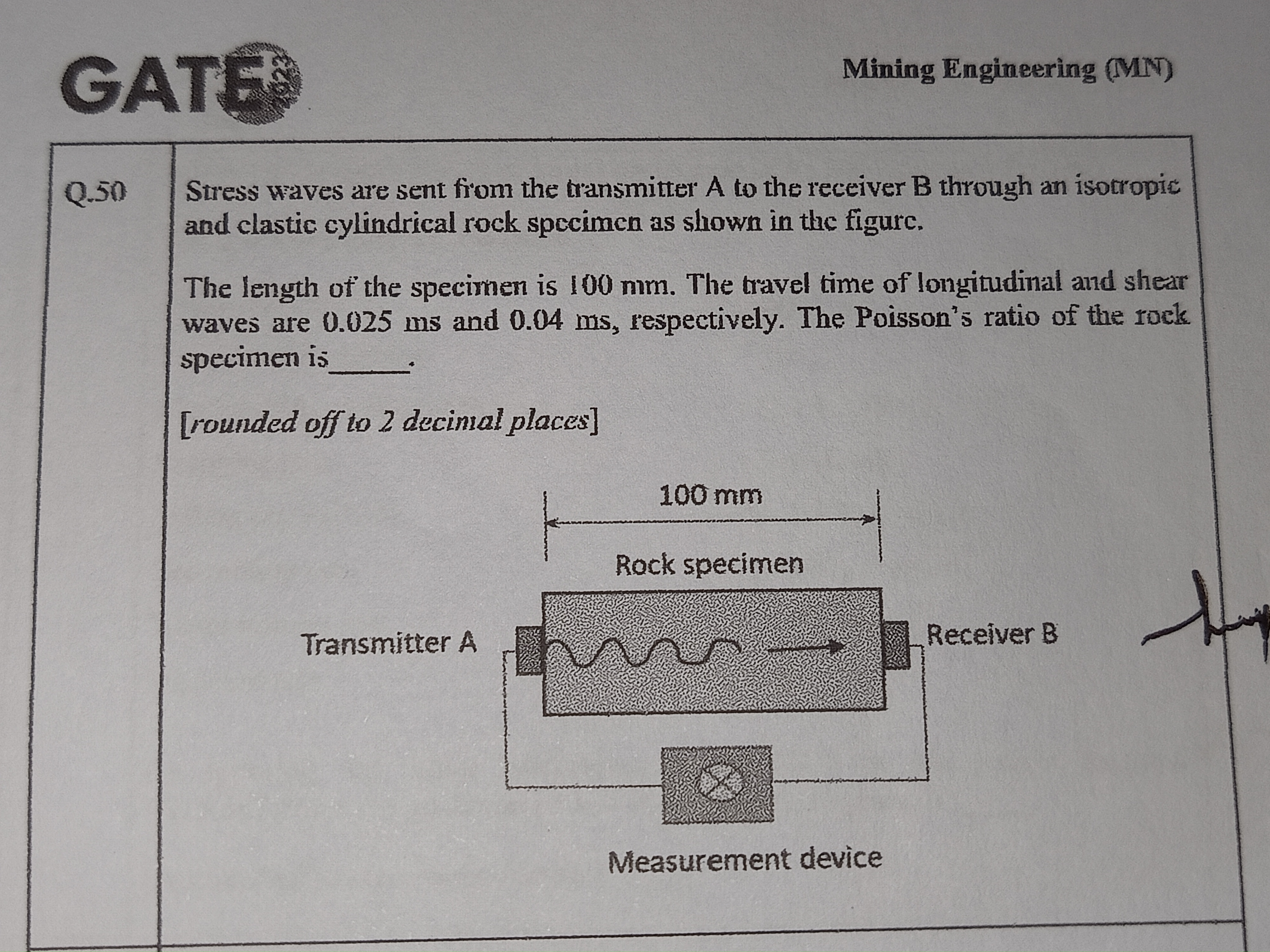Stress waves are sent from the transmitter A to the receiver B through an isotropic and elastic cylindrical rock specimen. The length of the specimen is 100 mm. The travel time of... Stress waves are sent from the transmitter A to the receiver B through an isotropic and elastic cylindrical rock specimen. The length of the specimen is 100 mm. The travel time of longitudinal and shear waves are 0.025 ms and 0.04 ms, respectively. The Poisson's ratio of the rock specimen is _____ [rounded off to 2 decimal places].

Understand the Problem
The question involves calculating the Poisson's ratio of a rock specimen based on the travel times of longitudinal and shear stress waves, given specific lengths and times for those waves. We will need to use the relationship between the speeds of these waves and the Poisson's ratio for an isotropic material.
Answer
The Poisson's ratio of the rock specimen is approximately $0.18$.
Answer for screen readers
The Poisson's ratio of the rock specimen is approximately $0.18$.
Steps to Solve
- Calculate wave speeds To find the speeds of the longitudinal and shear waves, we need to use the formula for wave speed, which is given by: $$ v = \frac{d}{t} $$ where $d$ is the distance and $t$ is the travel time.
For the longitudinal wave: $$ v_L = \frac{100 \text{ mm}}{0.025 \text{ ms}} = \frac{100 \times 10^{-3} \text{ m}}{0.025 \times 10^{-3} \text{ s}} $$
For the shear wave: $$ v_S = \frac{100 \text{ mm}}{0.04 \text{ ms}} = \frac{100 \times 10^{-3} \text{ m}}{0.04 \times 10^{-3} \text{ s}} $$
- Calculate wave speeds numerically Calculating the speeds numerically, we have:
For longitudinal wave: $$ v_L = \frac{0.1 \text{ m}}{0.000025 \text{ s}} = 4000 \text{ m/s} $$
For shear wave: $$ v_S = \frac{0.1 \text{ m}}{0.00004 \text{ s}} = 2500 \text{ m/s} $$
- Use the relation for Poisson's ratio For isotropic materials, Poisson's ratio $(\nu)$ can be calculated using the relation: $$ \nu = \frac{v_L^2 - 2v_S^2}{2(v_L^2 - v_S^2)} $$
Substituting the values obtained:
- $v_L = 4000 \text{ m/s}$
- $v_S = 2500 \text{ m/s}$
- Calculate Poisson's ratio Let's compute the numerator and denominator:
Numerator: $$ v_L^2 - 2v_S^2 = 4000^2 - 2 \times 2500^2 $$
Denominator: $$ 2(v_L^2 - v_S^2) = 2(4000^2 - 2500^2) $$
Then calculate: $$ \nu = \frac{4000^2 - 2(2500^2)}{2(4000^2 - 2500^2)} $$
- Final computation Calculate the individual components:
- $4000^2 = 16000000$
- $2500^2 = 6250000$
Now substitute: Numerator: $$ 16000000 - 2(6250000) = 16000000 - 12500000 = 3500000 $$
Denominator: $$ 2(16000000 - 6250000) = 2(9750000) = 19500000 $$
Then: $$ \nu \approx \frac{3500000}{19500000} $$
Calculate $\nu$ and round to two decimal places.
The Poisson's ratio of the rock specimen is approximately $0.18$.
More Information
Poisson's ratio quantifies the relationship between longitudinal strain and lateral strain in materials. It is crucial in engineering and geology, influencing the material's stability and performance under stress.
Tips
- Confusing units: Ensure to convert milliseconds to seconds properly.
- Forgetting to square velocities: Poisson’s ratio formula requires the squares of wave speeds.
- Rounding errors: Double check final calculations before rounding.
AI-generated content may contain errors. Please verify critical information